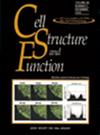荧光蛋白的折叠潜伏期影响融合蛋白的线粒体定位。
IF 2.2
4区 生物学
Q4 CELL BIOLOGY
引用次数: 0
摘要
荧光蛋白(FPs)的发现彻底改变了细胞生物学。目标序列与FPs的融合使研究细胞器及其动力学成为可能;然而,偶尔,这种荧光融合蛋白(FFPs)表现出与天然蛋白不同的行为。在这里,我们构建了一个包含不同细胞器标记的色板,发现靶向线粒体的FFPs在与某些类型的FPs融合时定位错误。这类FP包括维多利亚水梨绿色FP (avGFP)的几个变体和红色FP的一个单体变体。由于错误定位的FFPs包括成熟更快或折叠突变更快的FPs,成熟率的增加可能会阻止它们预期的定位。事实上,当我们重新引入氨基酸替换,使FP序列与野生型avGFP相当时,FFP在线粒体中的定位显著增强。此外,类似的氨基酸替换改善了线粒体靶向pHluorin的定位,它是GFP的pH敏感变体,并具有监测线粒体基质pH变化的能力。我们的研究结果证明了选择能够最大化FFP功能的FPs的重要性。关键词:荧光蛋白,细胞器,融合蛋白,线粒体。本文章由计算机程序翻译,如有差异,请以英文原文为准。
Folding Latency of Fluorescent Proteins Affects the Mitochondrial Localization of Fusion Proteins.
The discovery of fluorescent proteins (FPs) has revolutionized cell biology. The fusion of targeting sequences to FPs enables the investigation of cellular organelles and their dynamics; however, occasionally, such fluorescent fusion proteins (FFPs) exhibit behavior different from that of the native proteins. Here, we constructed a color pallet comprising different organelle markers and found that FFPs targeted to the mitochondria were mislocalized when fused to certain types of FPs. Such FPs included several variants of Aequorea victoria green FP (avGFP) and a monomeric variant of the red FP. Because the FFPs that are mislocalized include FPs with faster maturing or folding mutations, the increase in the maturation rate is likely to prevent their expected localization. Indeed, when we reintroduced amino acid substitutions so that the FP sequences were equivalent to that of wild-type avGFP, FFP localization to the mitochondria was significantly enhanced. Moreover, similar amino acid substitutions improved the localization of mitochondria-targeted pHluorin, which is a pH-sensitive variant of GFP, and its capability to monitor pH changes in the mitochondrial matrix. Our findings demonstrate the importance of selecting FPs that maximize FFP function.Key words: fluorescent protein, organelle, fusion protein, mitochondria.
求助全文
通过发布文献求助,成功后即可免费获取论文全文。
去求助
来源期刊

Cell structure and function
生物-细胞生物学
CiteScore
2.50
自引率
0.00%
发文量
6
审稿时长
>12 weeks
期刊介绍:
Cell Structure and Function is a fully peer-reviewed, fully Open Access journal. As the official English-language journal of the Japan Society for Cell Biology, it is published continuously online and biannually in print.
Cell Structure and Function publishes important, original contributions in all areas of molecular and cell biology. The journal welcomes the submission of manuscripts on research areas such as the cell nucleus, chromosomes, and gene expression; the cytoskeleton and cell motility; cell adhesion and the extracellular matrix; cell growth, differentiation and death; signal transduction; the protein life cycle; membrane traffic; and organelles.
 求助内容:
求助内容: 应助结果提醒方式:
应助结果提醒方式:


